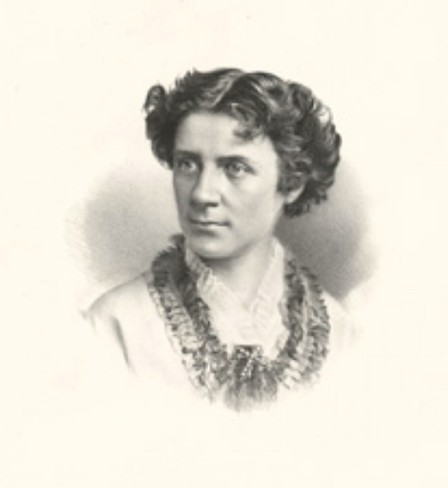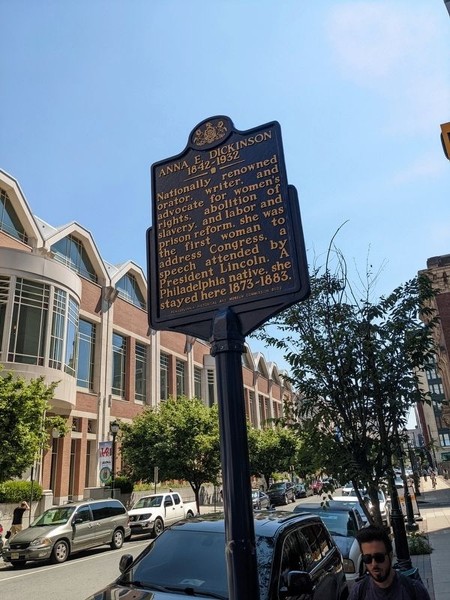Anna E. Dickinson Historical Marker
Introduction
Text-to-speech Audio
This historical marker acknowledges the life of the abolitionist Anna E. Dickinson (1842 - 1932), who was born in Philadelphia to a Quaker family. In addition to her commitment to ending slavery, she was a campaigner for women's rights and universal education, an advocate for labor and prison reform, and the first woman to address Congress. On the public lecture circuit, she spoke to thousands of listeners at prominent venues such as the Cooper Institute (Cooper Union) in New York City. In 1864, in the midst of the U.S. Civil War, she gave an impassioned speech to the House of Representatives and to President Abraham Lincoln, in which she voiced her support for the preservation of the Union while also pressing for equal rights for African Americans. As a white woman, Dickinson was influenced by other white abolitionists such as Lucretia Mott and William Lloyd Garrison, and by Black abolitionists such as Sojourner Truth and Frederick Douglass. She did not hesitate to defy the expectations that were placed upon her as a middle-class woman in the nineteenth century, in which she was expected to remain within the home. Instead, she confidently carried her message to the public sphere. For her deep commitment to the abolition of slavery, she was often called "Joan of Arc of the Civil War."
Images
Portrait of the abolitionist, Anna E. Dickinson

Historical Marker acknowledging the life of the abolitionist, Anna E. Dickinson, born in Philadelphia

In this 1869 photograph, Anna Dickinson is shown stepping off the train platform in Cheyenne (WY) where she gave a public lecture, as part of a national traveling tour with a U.S. congressional committee that took her to San Francisco. The transcontinental railroad was completed in 1869, making possible her public lecture tour throughout the Rocky Mountains and western U.S.
.jpg)
Backstory and Context
Text-to-speech Audio
Born in Philadelphia in 1842, Anna E. Dickinson was the youngest of five children. She was raised in a Quaker family and her father was an ardent abolitionist. In 1844, while campaigning against slavery, her father gave an impassioned speech but died of a heart attack soon after. As a result, Anna's mother raised the children on her own, homeschooling Anna until she was old enough to attend the Friends Select School of Philadelphia, followed by Westtown Boarding School. By age fifteen, Anna began working as a schoolteacher and transcriptionist. During the 19th century, middle- and upper-class women were expected to abide by a "cult of domesticity," adhering to virtues such as "piety, chastity, and submissiveness," while accepting that their place was in the home, not the public sphere. However, Anna Dickinson refused to abide by these societal norms and instead sought to make a place for herself by advocating for public causes, finding her voice on the stage. While still a teenager, she began giving public lectures that soon drew audiences by the thousands, as she spoke at important venues throughout the Northeast.
From a young age, Dickinson had absorbed the ideas of William Lloyd Garrison, embracing his fervent commitment to ending slavery, much as her own father had dedicated himself to the same cause. She wrote an essay for Garrison's anti-slavery newspaper, The Liberator, when she was just thirteen, which established her future course. A few years after the publication of the article, she embarked on a speaking tour in Boston, and then throughout the state of Massachusetts and New England. Her public speaking engagements brought in a modest income, which she used to support her family.
Although Dickinson initially became one of the first female employees at the U.S. Mint, she was fired from the position when she openly spoke out against Union policies during a public meeting, even criticizing the Union General George B. McClennan. Thereafter, she devoted herself to public causes, while becoming friends with the Quaker abolitionist, Lucretia Mott, who was rallying the Quaker community to anti-slavery efforts. As a white female abolitionist, Dickinson took inspiration from figures such as Mott, and also from Black female campaigners, such as Sojourner Truth, whose denouncement of slavery helped open up a space for other women to enter the public discourse and speak out, whether on the public stage or through writing and publishing.
Dickinson was nineteen when she embarked on a public lecture tour sponsored by the Massachusetts Anti-Slavery Society. She also gave a speech in Philadelphia titled "The Rights and Wrongs of Women." In this controversial speech, she argued that women should condemn slavery not only because they had a moral responsibility to end injustice, but also because women were the intellectual equals of men and were therefore capable of making reasoned, persuasive arguments. During her first appearance in New York City in her early twenties, she spoke to a crowd of 5,000 people at the Cooper Institute, a prominent venue now known as the Cooper Union for the Advancement of Art and Science.
In 1964, Dickinson became the first woman to speak in front of Congress, for which she received a standing ovation. She advocated for securing equal rights for African Americans and preserving the Union, yet she also did not hesitate to question President Abraham Lincoln, who was present at the speech. For her commitment, she was given the moniker, "Joan of Arc of the Civil War." A few years later, Dickinson wrote a novel titled, What Answer?, which was set during the Civil War and depicted an interracial marriage. Later, she also attempted to write and perform in plays, but her plays were not taken seriously because she was a woman, receiving much criticism. Still, at the height of her public speaking career, Dickinson was earning as much for her lectures as the acclaimed American author, Mark Twain. Twain attended one of her lectures and described the experience in a California newspaper article:
“She talks fast, uses no notes what ever...never hesitates for a word, always gets the right word in the right place, and has the most perfect confidence in herself. Indeed, her sentences are remarkably smoothly-woven and felicitous. Her vim, her energy, her determined look, her tremendous earnestness, would compel the respect and the attention of an audience, even if she spoke in Chinese..."
Following her commitment to abolitionism, Dickinson later campaigned on behalf of women's rights and universal education. At first, she diverged from the views of fellow women's rights advocates and contemporaries, Elizabeth Cady Stanton and Susan B. Anthony. Dickinson wanted to focus on securing voting rights for African American men, rather than campaigning for female suffrage, as this would have only been limited to white women at the time. However, she later embraced universal female suffrage. When the completion of the transcontinental railroad in 1869 made it possible for her to give public lectures throughout the country, she traveled with a U.S. congressional committee to San Francisco, visiting the Rocky Mountains along the way. A photograph shows her stepping off a train platform in Cheyenne for a breath of air. Following the public lecture she gave in that city in June 1869, a Cheyenne newspaper stated unequivocally that "Mrs. Stanton is the salt, Anna Dickinson is the pepper, and Miss Anthony the vinegar, of the modern women’s rights movement.”
Cite This Entry
Hughes, Jenevieve . "Anna E. Dickinson Historical Marker." Clio: Your Guide to History. December 16, 2022. Accessed March 30, 2025. https://theclio.com/tour/818/13/reverse
Sources
Anna Dickinson, Women History Blog. January 1st, 2007. Accessed December 16th, 2022. https://www.womenhistoryblog.com/2007/01/anna-dickinson.html.
Miller, Jennie. Meet Anna Dickinson: Trailblazing orator and political firebrand, National Museum of American History at the Smithsonian. September 1st, 2021. Accessed December 16th, 2022. https://americanhistory.si.edu/blog/anna-dickinson.
Tilton, Theodore. Notable Visitors: Anna Dickinson (1842-1932) Anna Dickinson, Mr. Lincoln's White House. Accessed December 16th, 2022. http://www.mrlincolnswhitehouse.org/residents-visitors/notable-visitors/notable-visitors-anna-dickinson-1842-1932/.
InCharlotte, Bruce . Anna E. Dickinson Historical Marker, Hmdb. October 10th, 2022. Accessed December 16th, 2022. https://www.hmdb.org/m.asp?m=207566.
Anna Dickinson (1842-1932) – Advocate for the Abolition of Slavery and for Woman’s Suffrage, Virginia Commonwealth University's Social Welfare History Project. Accessed December 16th, 2022. https://socialwelfare.library.vcu.edu/woman-suffrage/dickinson-anna-1842-1932/.
Rea, Tom . Feminist Orator Wows Territorial Cheyenne, Wyoming history. December 16th, 2019. Accessed December 16th, 2022. https://www.wyohistory.org/encyclopedia/feminist-orator-wows-territorial-cheyenne.
Smithsonian’s National Portrait Gallery
Wyoming State Archives

